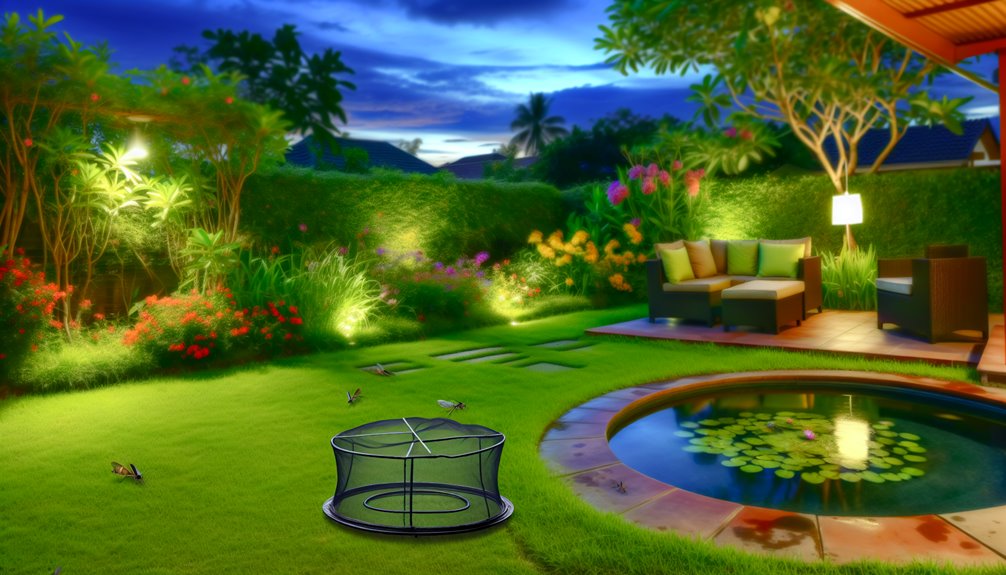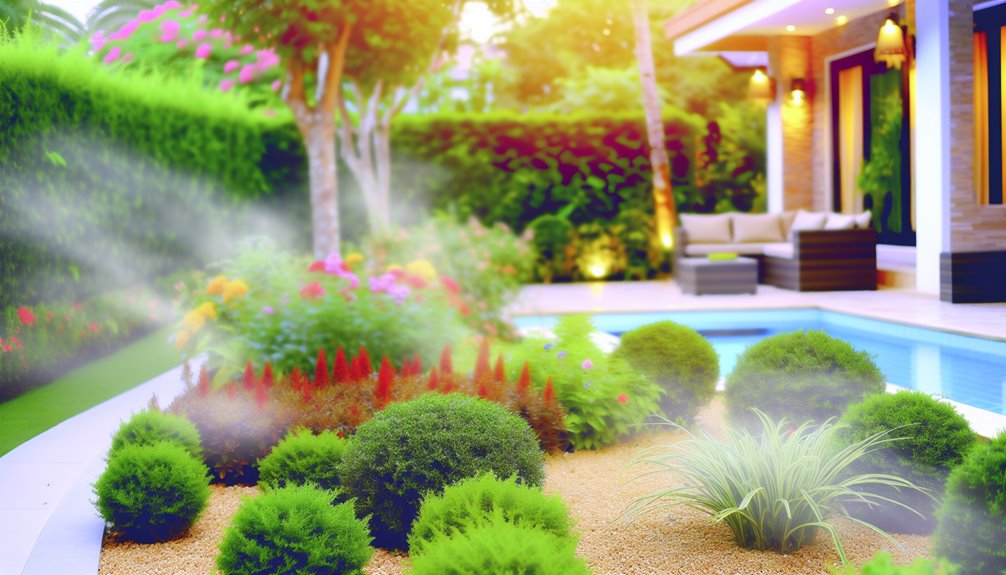Let’s talk about an uninvited outdoor inconvenience that quietly erodes comfort and value. When mosquitoes breed in clogged gutters, planters, and shaded thickets, they don’t just bite—they signal drainage issues, landscape neglect, and potential health risks. You can cut populations by disrupting breeding cycles, hardening water management, and timing treatments to life stages. With the right controls, you’ll protect curb appeal and buyer confidence—yet one common yard feature often undermines everything.
How Mosquitoes Impact Curb Appeal and Buyer Perception

Why does a buzzing nuisance at dusk lower a home’s perceived value? You see it in real time: mosquitoes disrupt curb appeal, signaling poor maintenance and health risks. Prospective visitors perceive unmanaged water, vegetation density, and lighting as indicators of neglect. Mosquito aesthetics matter; visible swarms, bites, and repellent odors degrade first impressions. Data link mosquito activity with vector-borne disease risk, elevating buyer concerns about safety and usability of outdoor space. You can mitigate perception by eliminating standing water, maintaining gutters, trimming foliage, and optimizing drainage. Specify fan airflow, screen mesh size (18×16), and larvicide labeling to demonstrate competence and care.
The Hidden Cost: Mosquitoes and Property Value
Even when you budget for cosmetic upgrades, mosquitoes impose hidden costs that erode property value through reduced usability, higher maintenance, and elevated risk. You lose evening hosting time, diminish rental appeal, and face buyer concessions when mosquito attraction is unchecked. Data show vector-borne disease advisories depress showings and prolong days on market. You’ll also incur recurring expenses for inspections, barrier treatments, and landscaping adjustments that protect property aesthetics. Noise and odor from ad hoc repellents can degrade neighbor satisfaction. By prioritizing prevention and safe, integrated control, you preserve outdoor livability, safeguard guests, and sustain valuation without compromising community well-being.
Identify Breeding Hotspots Around Your Home

Protecting value starts with eliminating the sources that produce mosquitoes on your lot. You’ll locate hotspots by inspecting every container, surface, and shelter zone. Focus on standing water: buckets, plant saucers, toys, tarps, birdbaths, wheelbarrows, and tire rims. Check irrigation control boxes, sump discharge pads, and HVAC condensate pans. Examine shaded areas where moisture persists—under decks, crawlspace vents, dense shrubs, and woodpiles. Verify that tree holes, fence-post caps, and clogged yard ornaments aren’t holding water. Flush and scrub containers weekly; document findings to guide service. Wear gloves and eye protection. If you steward shared spaces, coordinate checks to protect neighbors.
Drainage, Gutters, and Water Features: Fixing the Source
Although spray treatments can suppress adults, you cut mosquito pressure long-term by correcting how water moves and collects on the property. Inspect grade to guarantee water flows away from foundations; add drainage solutions like French drains or swales where pooling persists. Keep gutters pitched, cleared, and downspouts extended at least 6–10 feet. Seal or screen rain barrels. For water features, maintain circulation with pumps, clean filters weekly, and dose with EPA-registered Bti as labeled. Skim debris daily. Fix leaking hose bibs and irrigation overspray. Fill tree holes and depressions with sand or mortar. Document intervals, prioritize child-safe practices, and verify compliance with local codes.
Landscaping Strategies That Deter Mosquitoes

When you design the landscape to disrupt mosquito breeding and resting sites, you lower adult densities without relying on broad-spectrum sprays. You’ll get safer, longer-lasting control by manipulating structure and species composition. Prioritize native plants with upright forms and open airflow; avoid dense, ground-hugging thickets that trap humidity. Prune shrubs to lift canopies 18–24 inches, reducing cool, shaded refuges. Specify well-drained soils, raised beds, and permeable mulch; replace water-holding saucers with drip irrigation. In your outdoor design, cluster nectar sources away from gathering areas, and favor wind-tolerant species. Add aromatic, low-volatility herbs as borders. Maintain turf at 3–4 inches to limit resting sites.
Smart Use of Screens, Fans, and Outdoor Lighting
Even small adjustments to barriers, airflow, and spectra can cut mosquito encounters dramatically and without chemicals. Start with tight-mesh screen installation (≤1.5 mm openings) on patios and vents; seal gaps to prevent entry. Optimize fan placement to disrupt weak mosquito flight: position oscillating fans at seating height, directing cross-breezes of 1–2 m/s across ankles and wrists. For lighting, use warm LEDs (≤3000 K) with lower UV output; shield fixtures and aim downward to reduce attractants. Place motion-activated lights away from gathering areas. Maintain equipment: clean screens, confirm fan guards are intact, and verify electrical safety with outdoor-rated connections.
Targeted Treatments: When and How to Apply Safely
Since physical barriers and lighting reduce most encounters, reserve targeted treatments for specific risks you can verify: active larvae in standing water, resting adults in shaded harborage, or high-bite hotspots at dusk. Choose the least-toxic method application first: Bti/Bs larvicides for containers, oil films for unused cisterns, and residual adulticides on cool, windless mornings targeting undersides of foliage. Calibrate sprayers, follow label rates, and avoid drift to pollinator habitat and water bodies. Enforce safety precautions: PPE, nozzle control, reentry intervals, and child/pet exclusion. Document sites, products, and outcomes to refine coverage. If unsure, consult licensed professionals to protect guests and neighbors.
Seasonal Maintenance Checklist for Bite-Free Living
Targeted treatments work best within a structured, year-round plan, so build a seasonal checklist that prevents breeding and suppresses adult pressure before it peaks. In late winter, map water-collecting zones, calibrate sprayers, and repair screens. In spring, execute weekly tip-and-toss of containers, unclog gutters, refresh birdbath water every 48 hours, and trim dense vegetation. For summer, monitor larval habitats after rains, apply labeled larvicides to non-drainable water, and run fans during gatherings. In fall, reduce leaf litter, drain irrigation lines, and store equipment dry. Throughout, document seasonal tasks, align outdoor upkeep with local guidance, wear PPE, and verify product labels.
Partnering With Pros: What to Expect From Mosquito Services
How do professional mosquito services fit into an integrated, evidence-based control plan? You should set clear service expectations: site assessment, species identification, and a written, data-driven strategy. Pros deploy professional methods like source reduction, larval control (Bti, methoprene), and targeted adulticide applications with calibrated equipment. They verify drift control, label compliance, pollinator safeguards, and re-entry intervals. Expect monitoring through traps and larval dipping, plus measurable thresholds that trigger adjustments. You’ll receive documentation, treatment maps, and safety data sheets. Ask for product rotation to deter resistance, scheduling aligned to life cycles, and neighbor outreach. You remain the steward; they provide expertise.
Conclusion
As the proud owner of Mosquito Eliminators of South MS, I truly understand how important it is to enjoy your outdoor space without the nuisance of pesky mosquitoes. By taking proactive steps to manage mosquito populations, you can enhance not only your comfort but also the value of your property. If you’re looking for more tips or need assistance in creating a mosquito-free environment, I invite you to visit us at mosquitoeliminatorsms.com or give us a call at (601) 336-2277. Let’s work together to make your outdoor area a welcoming oasis!

